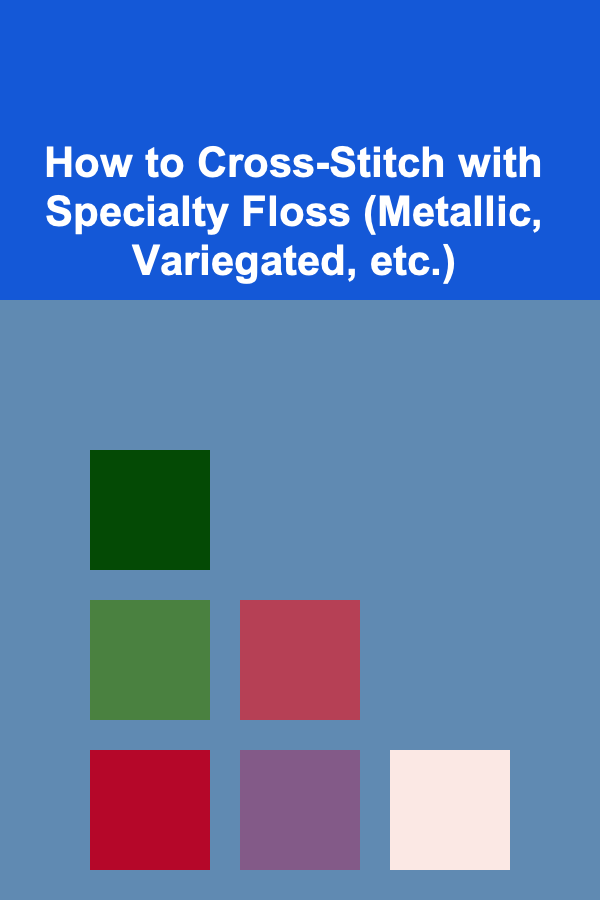
How to Color Bookmarks Inspired by Vintage Illustrations
ebook include PDF & Audio bundle (Micro Guide)
$12.99$9.99
Limited Time Offer! Order within the next:

In the world of book lovers and collectors, bookmarks serve not just as practical tools for marking one's place in a book, but also as a canvas for creativity. When you draw inspiration from vintage illustrations, coloring bookmarks becomes an opportunity to combine both nostalgia and artistry, creating personalized, visually stunning pieces that carry the charm of bygone eras.
Vintage illustrations---whether from the Victorian era, early 20th century, or mid-century designs---often feature ornate details, intricate patterns, and a rich color palette that can evoke feelings of history and timeless elegance. Coloring bookmarks inspired by these illustrations allows for an enjoyable, meditative process that connects one with the artistic movements of the past.
In this article, we'll explore how to create and color bookmarks inspired by vintage illustrations, delving into techniques, tips, and tools that will help you bring these beautiful designs to life.
Understanding Vintage Illustrations
Before we begin coloring, it's helpful to understand the essence of vintage illustrations. These images often have distinctive characteristics that set them apart from modern art:
- Intricate Detailing: Vintage illustrations tend to be highly detailed, with delicate linework that demands attention and precision.
- Soft and Muted Color Palettes: Unlike the bright neon colors of modern designs, vintage illustrations often feature soft, muted tones---pale pastels, earthy hues, or faded tones that give a sense of age.
- Whimsical and Nostalgic Themes: Many vintage illustrations revolve around themes of nature, animals, flora, fauna, fairytales, and fantasy, with a soft, dreamlike quality.
- Art Nouveau and Art Deco Influence: Certain styles within vintage illustrations, such as Art Nouveau and Art Deco, feature flowing lines, geometric shapes, and ornamental patterns.
To color bookmarks inspired by vintage illustrations, it's essential to study and embrace these stylistic elements. The goal is to reproduce not just the colors, but the feeling and essence of these historical pieces.
Choosing Your Vintage Illustration
The first step in coloring bookmarks inspired by vintage illustrations is selecting the right design. Vintage illustrations are vast in style, and they come in many forms---from botanical illustrations to illustrations in old children's books, from advertisements of the early 20th century to illustrations by famous artists like Alphonse Mucha or Norman Rockwell.
Sources for Vintage Illustrations:
- Public Domain Archives: Many vintage illustrations are available in the public domain, especially those from the early 1900s or before. Websites like The New York Public Library Digital Collections, Internet Archive, and Project Gutenberg offer free access to historical images.
- Old Books and Magazines: Antique books and magazines are a goldmine for vintage illustrations. Try visiting second-hand bookstores or antique stores for original copies that you can scan and use.
- Art and Design Museums: Many museums offer digitized collections of vintage illustrations that you can view online.
- Pinterest and Etsy: Platforms like Pinterest and Etsy often showcase vintage artwork or offer printable illustrations that can be turned into bookmarks.
When choosing an illustration, look for something that resonates with you and has elements that can be enhanced with color. Whether it's a floral motif, a vintage portrait, or a whimsical landscape, find an image that will translate well into a bookmark format.
Designing Your Bookmark Layout
Once you've chosen your vintage illustration, you need to think about how you want to present it as a bookmark. Bookmarks are typically longer than they are wide, so you might need to adjust the aspect ratio of the illustration.
Steps to Design Your Bookmark Layout:
- Resize the Image: Start by resizing the image to fit the dimensions of a bookmark. A standard bookmark size is 2 inches by 6 inches (5 cm by 15 cm), but you can adjust it based on your preferences.
- Consider the Borders: Vintage illustrations often look best when framed. You can add decorative borders around the edges of the bookmark, either replicating a vintage style or keeping it simple to let the illustration shine.
- Focus on Key Elements: Since bookmarks are small, it's important to highlight key elements of the illustration. This could be a specific character, flower, animal, or scene that you want to emphasize.
- Background or Negative Space: Decide whether you want to keep the background minimalistic or add additional elements. Vintage designs often make use of ample negative space, which helps create balance and focus.
By adjusting the layout, you can ensure that the illustration's details are highlighted in a way that suits the narrow proportions of a bookmark.
Selecting the Right Materials
The materials you use to color your bookmarks are just as important as the technique itself. Choosing the right medium can enhance the look and feel of the vintage illustration you're coloring.
Best Materials for Coloring Vintage Illustrations:
- Colored Pencils: Colored pencils are ideal for vintage-inspired illustrations due to their precision and ability to layer colors. They allow for fine details and subtle blending, which works well for vintage designs that often have delicate linework.
- Watercolor Pencils: Watercolor pencils can add a soft, vintage feel to your bookmarks. When activated with water, they create a watercolor effect that mimics the soft washes of color often found in vintage illustrations.
- Markers: If you're aiming for bold, vibrant colors, markers are a great choice. Brush markers, in particular, allow for both delicate strokes and bold fills, making them versatile for vintage designs.
- Pastels: Soft pastels or chalk pastels can provide a lovely, smooth finish that gives your bookmark an aged, faded look, reminiscent of illustrations from the early 1900s.
- Inks and Fineliners: For intricate detailing and shading, fine liners and inks can add definition and enhance the contrast in vintage illustrations. These can be particularly effective for adding texture and fine line work after you've added color.
It's essential to experiment with different mediums to find the one that suits the style of your vintage illustration.
Coloring Techniques for Vintage Illustrations
Now that you've chosen your materials, it's time to start coloring. The process of coloring vintage illustrations for bookmarks is about embracing subtlety and precision.
Techniques for Coloring:
- Layering and Blending: One of the hallmarks of vintage illustrations is the soft transitions between colors. To achieve this, use layering techniques with colored pencils or watercolor pencils. Start with light layers and build up the color gradually to create depth and dimension.
- Soft Washes for Watercolors: If you're using watercolors, apply soft washes of color, especially in the background or large areas. Avoid overly bright or stark colors; instead, focus on pastel shades or muted tones.
- Adding Shading and Texture: Use darker colors for shading to give depth to the illustration. Vintage illustrations often use soft gradients of color to suggest shadows and texture. Whether you're shading the folds of a dress, the petals of a flower, or the fur of an animal, keep the transitions subtle and smooth.
- Highlighting with White: Once the color is applied, you can use a white pencil or gel pen to add highlights, especially on areas like the eyes, jewelry, or light sources in the illustration. This will help to bring out the finer details and add dimension to your design.
- Minimalist Approach: If you want a more simplified version of a vintage look, consider a minimalist approach where you use a limited color palette---perhaps just a few soft hues---to create an almost monochromatic design. Vintage illustrations often embrace simplicity in color choice.
By taking your time and embracing the softer, more subtle techniques, you'll be able to capture the nostalgic spirit of vintage illustrations.
Finishing Touches: Adding Vintage Effects
After you've finished coloring, you can give your bookmark a final vintage touch to make it look even more authentic.
Final Touches:
- Aging the Paper: If you're working with printable bookmarks, you can make the paper look older by gently staining it with tea or coffee. This will give the bookmark a slightly yellowed, aged appearance that mimics the look of old prints.
- Distressing Edges: Use a distressing tool or gently rub the edges of your bookmark with sandpaper to create a worn, vintage effect. This technique adds texture and helps give the piece a sense of history.
- Sealing the Artwork: If you want to protect your bookmark and enhance the colors, consider sealing it with a clear varnish or spray sealant. This will protect the artwork from wear and tear while preserving the colors.
Once these final touches are completed, your vintage-inspired bookmark is ready to be used, or gifted, as a beautiful and functional piece of art.
Conclusion
Coloring bookmarks inspired by vintage illustrations is not only an enjoyable activity, but also a way to create meaningful, personalized pieces that carry the timeless charm of a bygone era. Whether you're an avid book lover, an artist, or someone who simply appreciates the beauty of vintage design, this process allows you to connect with history and bring it into the modern world.
By carefully choosing the right illustration, using suitable materials, and applying coloring techniques that capture the subtle beauty of vintage art, you can create bookmarks that are both visually striking and full of character. These bookmarks aren't just markers for books---they're miniature works of art that embody the nostalgia of past eras.
So next time you reach for your favorite book, don't just use any old bookmark---use one that you've colored and crafted, inspired by the elegance and grace of vintage illustrations.
Reading More From Our Other Websites
- [Home Rental Property 101] How to Create a Comprehensive Rental Agreement
- [Personal Investment 101] How to Profit from AI Automation Using Deep Learning
- [Organization Tip 101] How to Use a Bulletin Board for Laundry Reminders
- [Organization Tip 101] How to Maintain Your Floor After Installing Self-Leveling Underlayment
- [Home Budget Decorating 101] How to Mix and Match Affordable Furniture Pieces for a Unique Look
- [Home Lighting 101] How to Hang Pendant Lighting for a Charming Home Atmosphere
- [Home Party Planning 101] How to Organize a Party Playlist That Keeps Everyone Dancing
- [Home Lighting 101] How to Choose Lighting for Your Home's Open Concept Floor Plan
- [Scrapbooking Tip 101] DIY Textured Cardstock Techniques: Elevate Your Scrapbook Pages
- [Personal Investment 101] How to Review and Rebalance Your Investment Portfolio

How to Add a Touch of Luxury to Your Holiday Decorations
Read More
How to Create Persuasive Product Descriptions that Convert in Your Dropshipping Store
Read More
Why Understanding Feng Shui Can Help with Organization
Read More
**How To Develop Strategic Partnerships for Small Business Growth**
Read More
How to Cultivate Self-Compassion
Read More
How to Cross-Stitch with Specialty Floss (Metallic, Variegated, etc.)
Read MoreOther Products

How to Add a Touch of Luxury to Your Holiday Decorations
Read More
How to Create Persuasive Product Descriptions that Convert in Your Dropshipping Store
Read More
Why Understanding Feng Shui Can Help with Organization
Read More
**How To Develop Strategic Partnerships for Small Business Growth**
Read More
How to Cultivate Self-Compassion
Read More